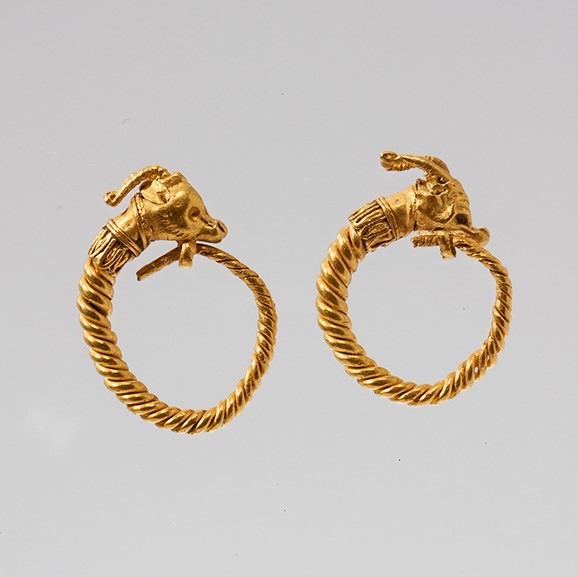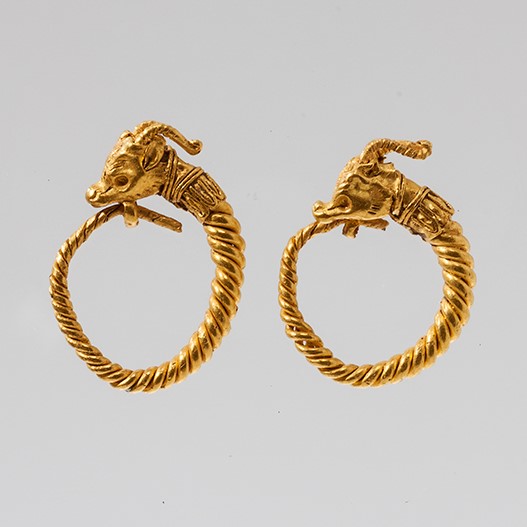Acquisition number: 1986.01
Intact and in good condition. Each earring is in the form of an antelope’s head with a calyx at the neck from which runs the loop of decreasing diameter of spirally-wound gold wire. There is a ring below the chin to receive the end of the loop. The animal horns have engraved spirals and they finish in a small, tight volute.
Fine workmanship.
Title: Pair of Gold Earrings - 1986.01
Acquisition number: 1986.01
Author or editor: J.R. Green
Culture or period: Hellenistic.
Date: c. 300 BC.
Material: Metal - Gold
Object type: Jewellery
Dimensions: 15mm (l) × 15mm (w)
Origin region or location: Greece
Display case or on loan: 4
Keywords: Greek, Hellenistic, earring, Alexander, Macedon
Sotheby (London), Sale Cat., 19 May 1986, no. 67, pl. IV; E. Bollen et al., Beauty & Betrayal. Ancient and Neo-Classical Jewellery (exhib. cat., Nicholson Museum, Sydney 2010) (Sydney 2010) 25 no. 2 (colour ill.).
1986.01
Pair of Gold Earrings
Purchased. Diam. ca 1.5cm.
Intact and in good condition. Each earring is in the form of an antelope’s head with a calyx at the neck from which runs the loop of decreasing diameter of spirally-wound gold wire. There is a ring below the chin to receive the end of the loop. The animal horns have engraved spirals and they finish in a small, tight volute.
Fine workmanship.
Another pair virtually the same as this is Boston 14.3: J.J. Herrmann, Jr., In the Shadow of the Acropolis. Popular and Private Art in 4th Century Athens (Exhib.Cat., Brockton MA, 1984) 78-79 no. 144 (ill.). It is dated to the late fourth century BC. Herrmann quotes other examples including H. Hoffmann and P. Davidson, Greek Gold: Jewellery from the Age of Alexander (Mainz 1965) 107 nos 27 and 28; the latter, in Brooklyn, is published more fully in The Search for Alexander: An Exhibition (Washington DC, 1980) no. 70 (ill.) (A. Herrmann), and P.F. Davidson and A. Oliver, Jr, Ancient Greek and Roman Gold Jewellery in the Brooklyn Museum (Brooklyn 1984) 48 no. 42. There is another pair in the Logie Collection in Christchurch: Green, Cat. Logie Coll. no. 128 (colour ill.).
Ariel Herrmann notes that this dome-skulled antelope is a stylised beast which entered the Greek repertory via Persian art. She adds that similar earrings appear throughout the Hellenistic world for a while in the late fourth and early third century BC. For other comparabilia, see D.G. Romano and I.B. Romano, Catalogue of the Classical Collections of the Glencairn Museum (Bryn Athyn, PA, 1999) 168 no. 253 (ill.); Aspects of Ancient Greece (Exhib.Cat. Allentown Art Museum, Allentown PA, 1979) 285-6 no. 142 (ill.); W. Hornbostel, Kunst der Antike (Mainz, 1977) 477 no. 422 (where Herbert Hoffmann points out that virtually all larger collections possess an example). See too Antikenmuseum Berlin. Die ausgestellten Werke (Berlin 1988) 326-327 no. 17 in a plate showing a variety of earrings of this period (= A. Greifenhagen, Schmuckarbeiten in Edelmetall, i [Berlin 1970] pl. 22, 2). A list of examples is provided by T. Hackens, Museum of Art, Rhode Island School of Design: Classical Jewelry (Providence 1976) 80, under no. 27.
A helpful short overview of jewellery of this period and the role of Macedon in promoting it is M. Barry, “Late Classical to Hellenistic”, in: T. Hackens and R. Winkes (eds), Gold Jewelry: Craft, Style and Meaning from Mycenae to Constantinopolis (Louvain-la-Neuve, 1983) 63-68. Under Philip there had been increasing exploitation of the Pangaion gold deposits, and then, under Alexander, much captured Persian gold.
Compare too the pieces in Lipari in L. Bernabò Brea and M.Cavalier (eds), Bellezza ed eleganza femminile nella Lipari greca ed ellenistica (Palermo 2005).
On the manufacture of gold wire, it is worth noting the salutary comments of J.M. Ogden, “Classical Gold Wire: Some Aspects of its Manufacture and Use”, Jewellery Studies 5, 1991, 95-105.
Sotheby (London), Sale Cat., 19 May 1986, no. 67, pl. IV; E. Bollen et al., Beauty & Betrayal. Ancient and Neo-Classical Jewellery (exhib. cat., Nicholson Museum, Sydney 2010) (Sydney 2010) 25 no. 2 (colour ill.).

